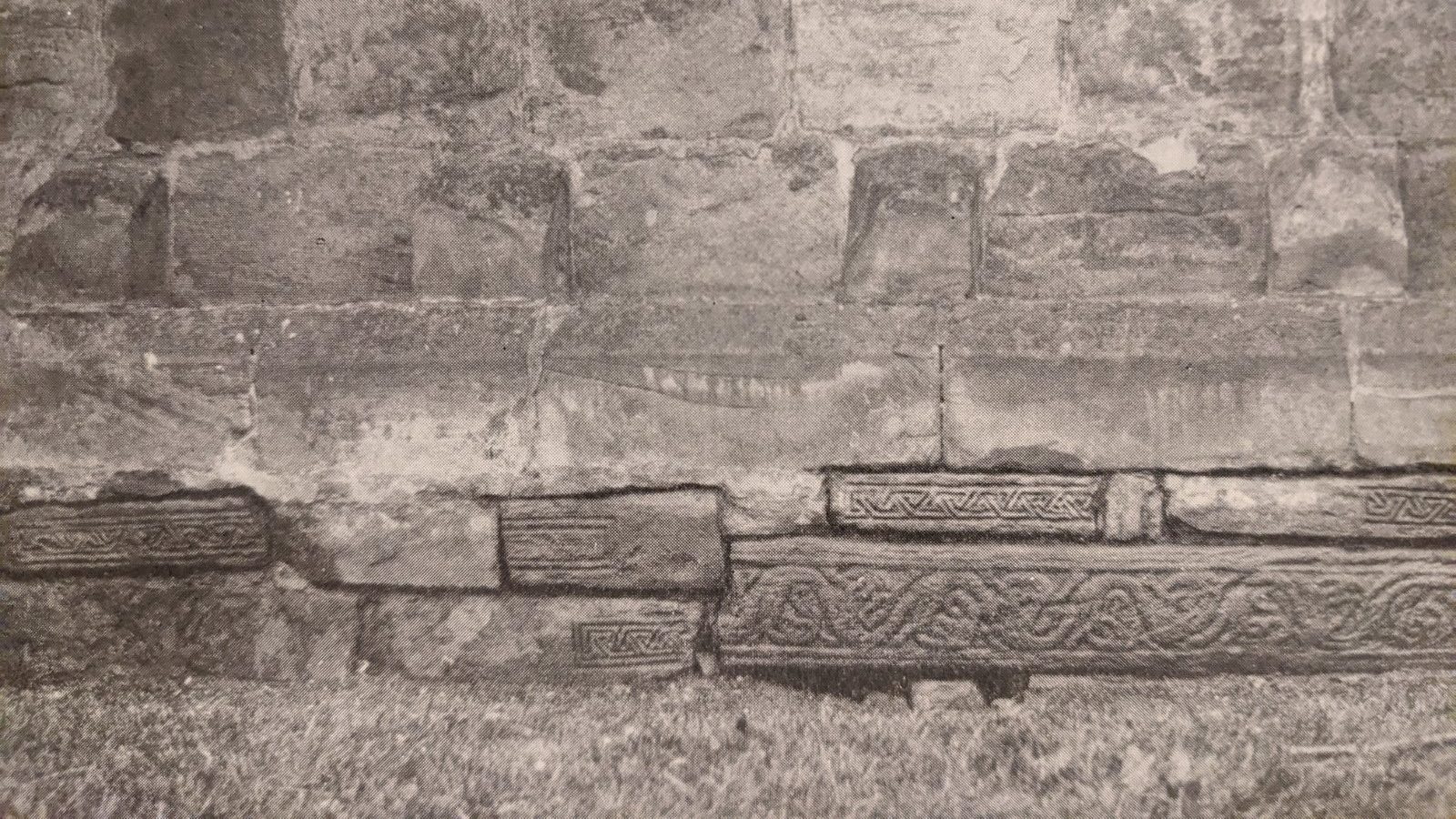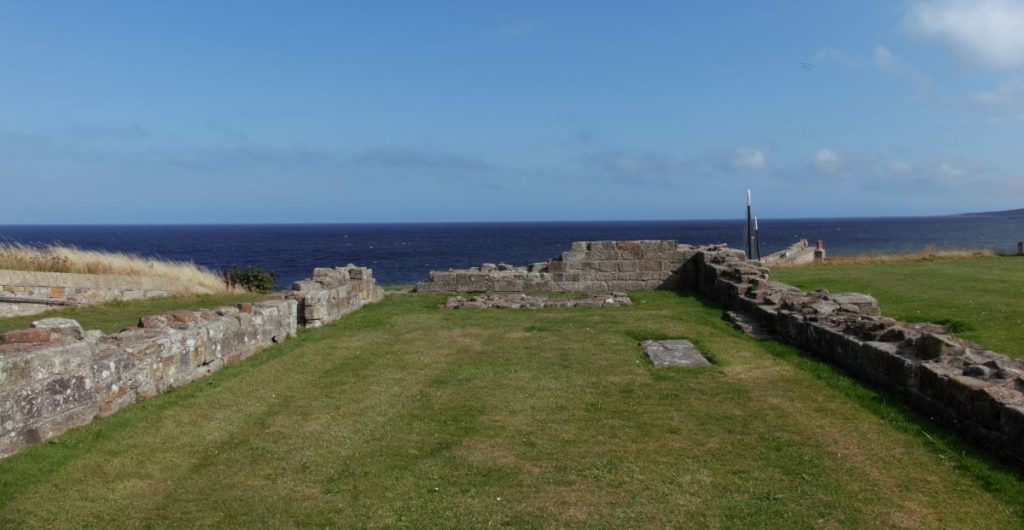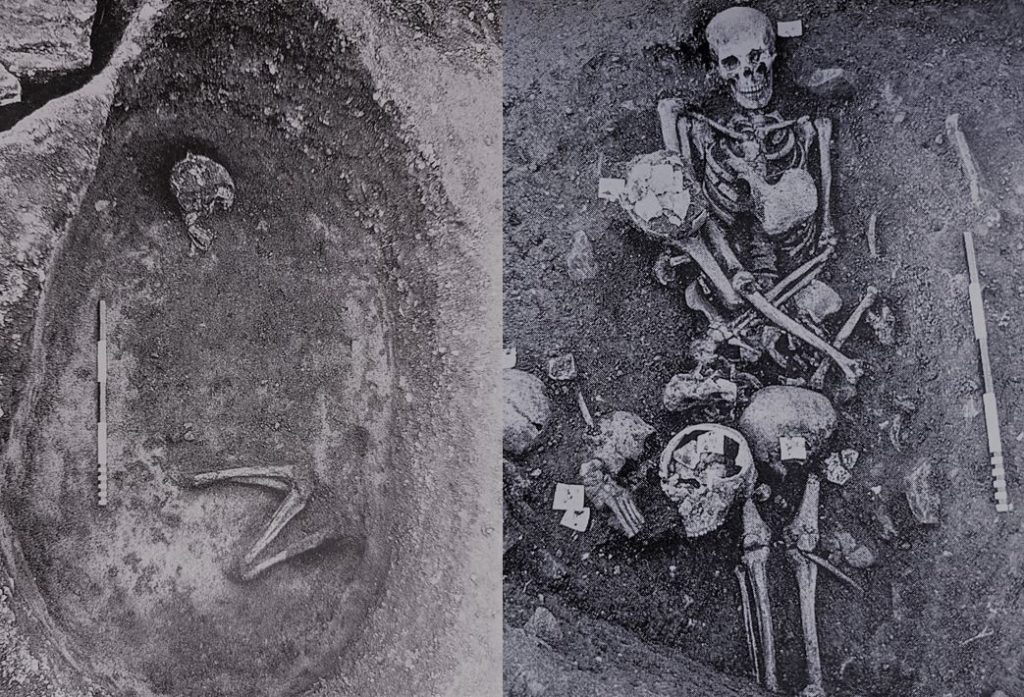St Andrews
Early Christianity
St Andrews was a major religious centre from an early date. There is evidence of a significant abbey here in the 740s, when the death of the abbot was recorded in the Annals of Ulster.1 The fact that the death of a churchman in Fife was noted as far away as Ireland indicates this was a high-status community which engaged with wider religious networks. At this time St Andrews was known as Kinrymont or Cinrigh Monai – which probably meant the ‘end’ or ‘head’ of the king’s ‘muir’ or ‘rough grazing’ land.
The Earliest Reference to St Andrews
747 A.D. ‘The death of Tuathalán abbot of Kinrymont’.
Seán Mac Airt and Gearóid Mac Niocaill, eds, The Annals of Ulster (Dublin, 1983), vol. 1, p. 202.

Archaeological evidence further supports the idea that Kinrymont was an important religious site. The area around St Andrews Cathedral has produced one of the largest collections of early medieval carved stones in the British Isles.3 These include the remains of tall free-standing crosses and numerous intricately carved cross-slabs. Many of these carved stones had been reused for building materials later in the Middle Ages.4
The most remarkable early stone monument found in the Cathedral is the richly decorated St Andrews Sarcophagus. This was dug up in 1833 near the present-day St Rule’s Tower, and may have been a shrine to a Pictish king.5 The so-called ‘sarcophagus’ probably dates from the eighth or ninth century, and its elaborate carving has similarities with Continental European art of the time. In particular the large figure tearing apart the jaws of a lion (thought to represent King David) shows signs of Mediterranean influence – another hint of cultural contact between Kinrymont and the wider world.6

The Discovery of the St Andrews Sarcophagus
‘In 1833, a grave was dug deeper than the foundations of the Cathedral itself, and 6 or 8 feet lower than the floor, and here the first fragments of the sarcophagus were found. On their character being explained to the Rev. Mr Lyon, by whom a very faithful drawing of the principal panel had been made, a separate search was instituted, and some farther fragments discovered; and it is more than probable that, had pains enough been taken, the whole would have been brought to light. But so lightly were these priceless relics prized at the seat of the oldest University in Scotland, that for six years they lay tumbling about as if of no interest or consequence to any one…’
George Buist, ‘On the Ancient Sculptured Monument Discovered at St Andrews, in 1833’, Proceedings of the Society of Antiquaries of Scotland, vol. 1, no. 3 (1851), pp. 234-237.


Image (Right): A Christian burial from St Mary’s on the Rock. The skeleton is aligned with the feet to the east and the arms crossed. There are also bones from other burials which have been disturbed – a reminder of the density of the human remains in this area. (Source: Rains and Hall, eds, Excavations in St Andrews, pp. 12, 14.)
Much of the religious activity in Kinrymont seems to have been focused on the east end of the St Andrews headland, in the area now covered by the remains of the Cathedral and St Mary’s on the Rock. In the 1980s archaeologists uncovered more than 300 burials (including the remains of men, women, and children) on the cliffs beside the medieval church of St Mary.7 Most of these graves pre-date the construction of the church. However, the alignment of the bodies (with their feet facing east), and the lack of grave goods suggest they were Christian. The majority of the burials showed no sign of coffins, although sea-pebbles were commonly discovered – perhaps having been used as weights for shrouds. Carbon-dating on a limited number of the excavated skeletons confirmed they were from the second half of the first millennium A.D. Interestingly, the excavations at St Mary’s on the Rock also revealed a small number of pre-Christian burials, where the bodies were located in a crouching position. There were perhaps six graves of this type, which have been tentatively dated to around 500 B.C.
While the heart of Kinrymont appears to have lain at the east end of the modern burgh of St Andrews, overlooking the sea, there is also evidence for early medieval religious activity a little further inland. The rise now known as Hallow Hill has produced a large number of long-cist burials, probably from between the sixth and ninth centuries A.D.8 The name Hallow Hill dates back to at least 1555.9 However, the earlier name for this area, Eglesnamin, also suggests religious associations, with egles appearing to be a Pictish word for a church.10
Hallow Hill stands by an early road, later known as Canongate. Connections with the wider world, whether by land or sea, seem to have characterised Kinrymont. In 965 A.D. the brother of the King of Tara died while on pilgrimage here.11 Sadly, our sources do not record which relics the unfortunate Irish royal was visiting. However, it seems likely that he had come to venerate the bones of St Andrew.
The Founding of Kinrymont According to a Twelfth-Century St Andrews Churchman
‘Afterwards King Hungus, with the holy men, came to Kilrymont, and… offered it to God and to Saint Andrew the Apostle to build there basilicas and oratories. Out of great devotion King Hungus and Bishop Regulus… and the other men went seven times round that very place… Having thus carried out the seven-fold circuit… Bishop Regulus processed carrying above his head the relics of the holy apostle with all veneration, with his holy company following the bishop with songs and hymns. And the devout King Hungus followed them on foot… pouring out profound prayers and thanks to God. And the most noble aristocrats of all the realm followed the king. Thus they commended that place to God, and fortified it with royal permission on 6 February. As a sign of royal favour, the holy men erected 12 stone crosses at intervals around the circumference of the place; and they humbly begged God… that all who pray in that place with a devout mind… may obtain the fulfilment of their petition.’
St Andrews Foundation Account B, in Taylor and Márkus, The Place-Names of Fife, vol. 3, p. 578.
We do not know exactly when or how the churchmen at Kinrymont acquired what were supposedly the apostle Andrew’s arm bone, three fingers, a head bone, a knee-cap, and a tooth.12 According to a legend written down in the twelfth century, St Andrew’s relics were brought from Greece to Fife by Bishop Regulus in the middle of the fourth century.13 The legend claimed that after being shipwrecked Regulus and his followers were given land at Kinrymont by the Pictish King Hungus, with the edge of their religious settlement marked by twelve stone crosses. Regarded as an accurate account of how the remains of one of Jesus’s disciples came to Fife this legend is deeply problematic. However, it does provide an interesting perspective on how St Andrews’ high medieval clerics perceived the history of their church, and perhaps their interactions with evidence of earlier religious practice (such as the stone crosses, which also feature in the archaeological record). Regarding the actual origin of the relics, it is possible that they came to Scotland from Northumbria, where St Andrew already had a following at Hexham in the 670s.14
As the twelfth-century foundation legend implies, early medieval Kinrymont seems to have enjoyed considerable royal support. Indeed, in the 940s the Scottish King Constantine retired to the religious community here.15 According to a note in a later list of kings, Constantine became ‘abbot of the keledei of St Andrew’.16
An Irish Poem Describes King Constantine’s Retirement to Kinrymont
‘Afterwards God has called him away, to the abbey-church on the brow of the wave. In the house of the apostle he will die; the pilgrim will be faithful.’
‘Berchan’s Prophecy’, in Alan Orr Anderson, Early Sources of Scottish History (Edinburgh, 1922), vol. 1, p. 448.
Singing at a Culdee Monastery in Ireland
‘A former layman was in company with “a son of life.” He said: “I do not understand your continual singing of the Beati and the Canticle of Mary.” “That is not hard to explain, truly,” said the other. “As a man… at the foot of the gallows, would pour out praise and lamentation to the king, to gain his deliverance; in like manner we pour forth lamentation to the King of Heaven in the Beati… And it is fitting… that the song which came from the head of the Virgin Mary, when she had conceived by the Holy Ghost… that this should be set as a crown upon the chant which contains praise of God…”’
E.J. Gwynn and W.J. Purton, eds, ‘The Monastery of Tallaght’, Proceedings of the Royal Irish Academy, 29C (1911-1912), pp. 115-180. Available here.
The keledei, or Culdees, were Christian holy men who followed a form of religious life developed in Ireland during the late eighth century.17 (The term Céli Dé means ‘client of God’ in Gaelic.) In contrast to later medieval monks, Culdees were allowed to marry and hold property.
The exact status of the Culdees in St Andrews is unclear. It has been suggested that they originally formed their own community, attached to a more conventional monastery.18 Yet, whatever their origins, by the early twelfth century the Culdees were clearly in charge of the shrine of St Andrew, and managing care for pilgrims.19
As well as being a centre for pilgrimage, Kinrymont became the seat of a major bishopric – a development that would profoundly influence St Andrews’ subsequent evolution. Late medieval chronicles note that the first bishop of St Andrews was appointed during the reign of the Pictish king Giric (approximately 878 to 889) – although this claim should be treated with some caution.20
Walter Bower Describes an Old Gospel Cover in St Andrews Cathedral
‘I have found this inscription round the edge of the silver cover of a gospel book which is still preserved at St Andrews:
“Fothad, who is the leading bishop among the Scots, made this cover for an ancestral gospel-book.”
Watt, ed., Scotichronicon, vol. 3, pp. 342-344.
From relatively early times the bishops based at Kinrymont seem to have enjoyed a special status. The Annals of Tigernach refer to Bishop Maoldùin (who died in 1055) as ‘bishop of Scotland and glory of the clergy of the Gaels’.21 Meanwhile a twelfth-century account of St Andrews’ history maintains that ‘from ancient times’ the bishops of St Andrews had been known as ‘High Bishops of the Scots’.22 Towards the end of the Middle Ages the great Cathedral at St Andrews apparently still had a very old gospel book with an inscription stating that it had been given by Fothad, ‘the leading bishop among the Scots’.23 The Fothad in question may have been a bishop who was active around the 950s, but more probably concerned a later Fothad who was bishop from about 1059 to 1093.24
The second Fothad was among the last of St Andrews’ bishops to bear a Celtic name. The twelfth century saw major changes to Christianity in Scotland, with Kinrymont (soon to be named St Andrews) at the heart of the new developments. Yet the themes of international connections, royal support, and a role at the heart of the Scottish Church would continue.